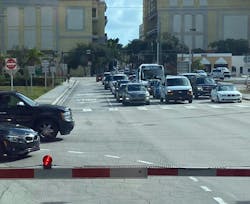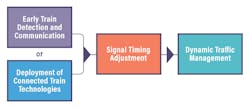Innovative Pre-Preemption Strategies for Traffic Light-Controlled Intersections Adjacent to Railroad Crossings
Traffic light-controlled intersections near crossings
Unique safety and mobility problems
Understanding preemption
The need for pre-preemption
Pre-preemption aims to anticipate and manage traffic flow proactively, rather than reacting only when a train is near.
- Early train detection and communication: Upstream train detection systems, such as track circuits or GPS-based technologies, identify an approaching train. This information is communicated to traffic light controllers at intersections adjacent to the railroad crossing.
- Deployment of connected train technologies: Trains equipped with communication devices can send real-time data about their location and speed to roadside units, traffic management systems and traffic light controllers, allowing for more precise and timely signal timing adjustments.
- Signal timing adjustment: Timings at traffic lights adjacent to the railroad crossing are adjusted before a regular preemption to manage and disperse traffic in advance. For example, traffic lights can be altered to allow more green time for traffic moving away from the railroad crossing, reducing the number of vehicles that might queue up on the tracks when the regular preemption takes place.
- Dynamic traffic management: Smart systems use real-time data from traffic sensors to adjust traffic lights based on current conditions. This helps prevent long lines of cars and ensures smoother traffic flow. This action is optional but highly recommended.
Benefits of pre-preemption
Real-world implementation
Future direction and challenges
- Integration and compatibility: Ensuring seamless communication between railroad and traffic signal control systems is critical. This requires standardization and compatibility of technologies across different regions and jurisdictions.
- Cost and funding: Implementing pre-preemption systems can be costly, involving significant investment in infrastructure and technology. Securing funding and demonstrating the cost-benefit ratio to stakeholders are essential for successful deployment.
- Public awareness and education: Educating the public about the benefits of pre-preemption and how it works is important to gain community support and ensure compliance with traffic signal operations.
- Continuous monitoring and adaptation: Traffic patterns and train schedules can change over time. Continuous monitoring and the ability to adapt signal timings and strategies are crucial for maintaining the effectiveness of pre-preemption systems.
Conclusion
About the Author

Pei-Sung Lin, Ph.D., P.E., PTOE, FITE
Director of ITS, Traffic Operations and Safety Program
Pei-Sung Lin, Ph.D., P.E., PTOE, FITE, is the director of ITS, Traffic Operations and Safety Program at the Center for Urban Transportation Research (CUTR), a courtesy professor in the Civil and Environmental Engineering Department at the University of South Florida (USF) and the director of the Florida Local Technical Assistance Program.

Zhenyu Wang, Ph.D.
Senior Research Faculty Member
Dr. Zhenyu Wang is a senior research faculty member at the Center for Urban Transportation Research (CUTR) at the University of South Florida (USF). With 15 years of experience in traffic safety, crash analysis, real-world driving studies, and traffic simulation, he has led over 30 research projects funded by organizations like the Florida Department of Transportation (FDOT), the U.S. Department of Transportation (USDOT), and the National Cooperative Highway Research Program (NCHRP).

